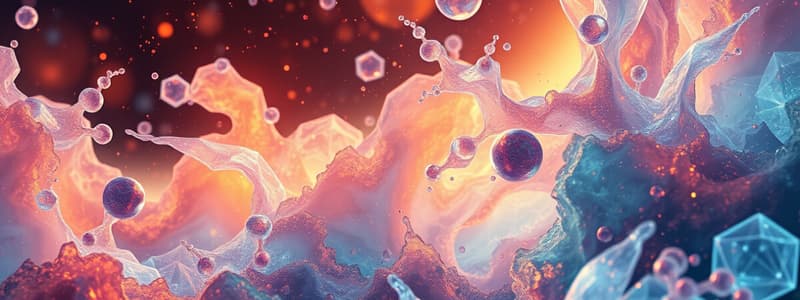Podcast
Questions and Answers
What distinguishes a pure substance from a mixture?
What distinguishes a pure substance from a mixture?
- A mixture cannot be separated into its components.
- A pure substance has a fixed composition. (correct)
- A mixture is always homogeneous.
- A pure substance has a variable composition.
Which of the following is true about diatomic elements?
Which of the following is true about diatomic elements?
- They are always gaseous compounds.
- They consist of two different elements.
- They are only found in gaseous form.
- They naturally occur as molecules made up of two identical atoms. (correct)
What does the mass number (A) represent in an atom?
What does the mass number (A) represent in an atom?
- The total number of protons and electrons combined.
- The total number of protons and neutrons combined. (correct)
- The total number of protons only.
- The total number of neutrons only.
Which statement accurately describes isotopes?
Which statement accurately describes isotopes?
According to the law of constant composition, which of the following is accurate?
According to the law of constant composition, which of the following is accurate?
What is the definition of a compound?
What is the definition of a compound?
Which statement correctly describes a molecule?
Which statement correctly describes a molecule?
What does the law of conservation of mass state?
What does the law of conservation of mass state?
If water (H2O) is considered a compound, which of the following is true?
If water (H2O) is considered a compound, which of the following is true?
Which of the following is NOT one of the seven diatomic elements?
Which of the following is NOT one of the seven diatomic elements?
Which statement correctly describes the characteristics of diatomic elements?
Which statement correctly describes the characteristics of diatomic elements?
Flashcards are hidden until you start studying
Study Notes
Understanding Matter
- Matter is defined as anything that occupies space and has mass.
- Two main categories of matter: pure substances and mixtures.
Pure Substances vs. Mixtures
- Pure Substance: Has a fixed composition and cannot be separated. Examples include elements (like Carbon, Hydrogen) and compounds (like water, H2O).
- Mixture: Combines two or more pure substances. Can be classified as homogenous (uniform composition) or heterogeneous (distinct regions). Examples include blood, air, and metals.
Elements and Compounds
- Element: Composed of identical atoms.
- Compound: Formed from two or more different elements in fixed mass ratios.
Molecules
- A molecule consists of two or more atoms bonded together, functioning as a single unit.
Fundamental Laws
- Law of Conservation of Mass: Matter cannot be created or destroyed in a chemical reaction.
- Law of Constant Composition: Any given compound always contains the same proportions of its constituent elements by mass.
Types of Elements
- Monatomic Elements: Elements existing as single atoms, e.g., Helium, Neon (Ne), Argon (Ar).
- Diatomic Elements: Molecules formed from two identical atoms. Key examples include:
- Hydrogen (H₂)
- Oxygen (O₂)
- Nitrogen (N₂)
- Fluorine (F₂)
- Chlorine (Cl₂)
- Bromine (Br₂)
- Iodine (I₂)
- Use the mnemonic HONClBrIF or BrINClHOF to remember these elements.
Atomic Structure
- Atoms are composed of subatomic particles:
- Protons (+1 charge)
- Electrons (-1 charge)
- Neutrons (neutral charge)
- Mass Number (A): Total count of protons and neutrons, represented as A = Z + N.
- Z: Atomic number (number of protons).
- N: Number of neutrons.
- Atomic mass number is a whole number and differs among isotopes of the same element due to varying neutron counts.
Isotopes
- Isotopes: Atoms of the same element with identical proton counts but differing numbers of neutrons, affecting their mass.
Definitions of Key Terms
- Compound: A pure substance composed of two or more elements combined in a specific mass ratio. Example: Water (H2O) consists of hydrogen and oxygen in a 2:1 ratio.
- Molecule: A combination of two or more atoms bonded together that functions as a single entity. Molecules can consist of the same or different types of atoms.
Fundamental Principle
- Law of Conservation of Mass: This principle states that matter cannot be created or destroyed in a closed system. The total mass remains constant during a chemical reaction, as atoms are rearranged but not lost.
Diatomic Elements
- Diatomic elements consist of two identical atoms bonded together.
- There are seven recognized diatomic elements in nature.
List of Diatomic Elements
- Hydrogen (H₂): The lightest and most abundant element in the universe.
- Oxygen (O₂): Essential for respiration and combustion, making up about 21% of Earth's atmosphere.
- Nitrogen (N₂): Comprises around 78% of Earth's atmosphere, inert and crucial for plant growth.
- Fluorine (F₂): A highly reactive and electronegative gas known for forming strong bonds with other elements.
- Chlorine (Cl₂): Used in disinfection and bleaching, a greenish-yellow gas with a strong odor.
- Bromine (Br₂): A reddish-brown liquid at room temperature, used in flame retardants and some pharmaceuticals.
- Iodine (I₂): A purple-black solid that sublimates to a violet gas, essential for thyroid hormone production in humans.
Studying That Suits You
Use AI to generate personalized quizzes and flashcards to suit your learning preferences.




